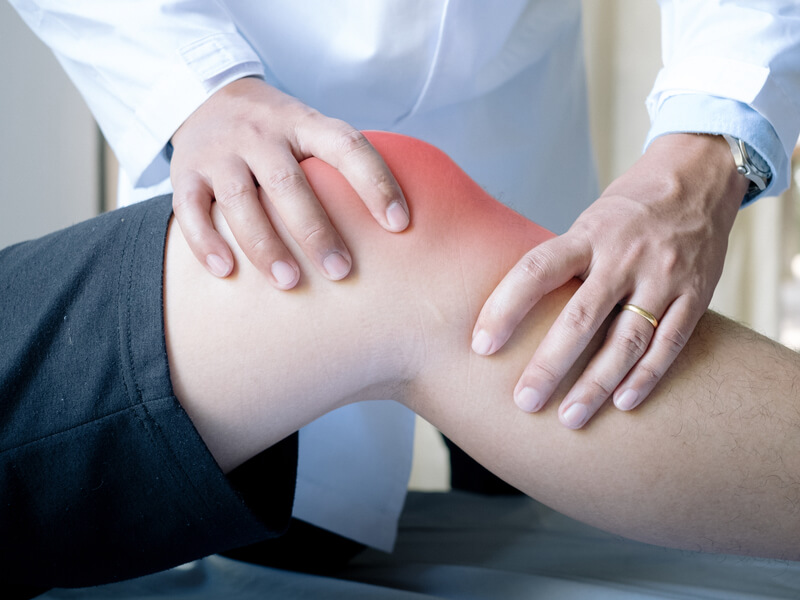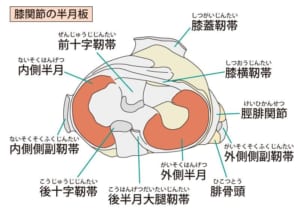
"Recently, my knee has been hurting."
"Difficult to bend and straighten the knee"
"I can't feel my knees when I'm walking"
Don't you feel like this for those who feel knee malfunction?
This symptom could be a meniscus injury.
Meniscus injuries can progress rapidly, but many people are unaware that the meniscus is injured and are often mistaken for common knee pain.
It is important to know the symptoms, causes, and treatments so that you do not leave it untreated and it does not get worse.
In this article, we will explain in detail the causes, symptoms, and treatment of meniscus injuries.
I would appreciate it if you could connect to early treatment by knowing about meniscus damage.
table of contents
Causes of meniscal injury
The meniscus is the tissue on the outside and inside of the knee joint.
The medial meniscus is especially vulnerable.
It is damaged when excessive force is applied to the joint.
For example, it can occur when the knee is stressed by strenuous sports or when a strong impact is applied to the knee, such as in a car accident.
Even if there is no strong impact, if the meniscus has degenerated and weakened due to aging, it may occur even in daily activities such as climbing light stairs.
In general, menisci are crescent-shaped, but some people are born with a large full-moon shape.
Meniscal injuries can also occur in childhood when these congenital knee features are present.
There are many different causes of meniscus injuries.
It is a disease that can occur in various life stages from childhood to old age, and meniscus damage should be suspected when there is knee pain.
Next, I will explain the characteristic symptoms of meniscal injury.

Symptoms of meniscus injury
The three main symptoms of a meniscus injury are:
- locking
- Knee collapse
- snapping
I will explain each one in detail.
locking
Rocking is when a ruptured meniscus gets caught in the joint gap, narrowing the knee's range of motion and making it difficult to straighten or bend deeply.
It is a symptom that affects not only walking but also other activities of daily living.
Knee collapse
Knee collapse is a sudden loss of strength in the knee while walking.
There is a risk of falling if it suddenly occurs while walking.
snapping
Snapping is a creaking feeling when the knee is deeply bent.
Even walking becomes difficult due to the pain and feeling of being caught in the knee.
In particular, when a large load is applied to the knee, such as when climbing stairs, the pain increases even more, and it may become difficult to carry out normal activities of daily living.
Examination of meniscal injury
If a meniscus injury is suspected, a test is done in which the doctor places a load on the meniscus by hand to reproduce the pain and sensation.
Imaging tests such as X-rays and MRIs can also be used for detailed evaluation.
X-rays can be used to assess the presence or absence of arthropathic changes associated with meniscus damage, and MRI can be used to see in detail what kind of meniscus damage has occurred.
MRI examination has a high diagnostic rate for meniscal injury and is considered to be a highly useful examination, and is an essential examination when meniscal injury is suspected.
Treatment of meniscus injuries
There are two main types of treatment for meniscus injuries: conservative treatment and surgical treatment.
There are two patterns of surgical treatment: excision and suture repair.
The meniscus, which acts as a cushion within the knee joint, does not regenerate when removed.
Therefore, suture repair is preferable from the viewpoint of function preservation, but depending on the degree of damage, suture repair may be difficult.
If it is difficult to repair with suturing, you may be able to see how it goes with conservative treatment such as the use of painkillers to alleviate symptoms and rehabilitation.
If the symptoms are still not relieved, partial meniscus excision may be taken.
There are many different treatments for meniscus.
It is important to listen to the pros and cons of treatment with an eye on life after treatment, and to make a decision while consulting with your doctor.
meniscal injury rehabilitation
Rehabilitation treatment is one of the conservative treatments for meniscal injury.
Rehabilitation for meniscus injuries varies depending on the treatment and the content and timing of rehabilitation.
It should be done after thorough consultation with the attending physician.
Here we will discuss some of the most common refurbishments.
joint range of motion training
Work on exercises to fully restore the range of motion of the knee joint.
When a meniscal injury occurs, the knee joint becomes difficult to move due to inflammation, and the damage causes adhesion between tissues, making it difficult to move the joint.
Therefore, it is necessary to exercise slowly and gradually to restore the range of motion of the joint.
Unreasonable movements can have the opposite effect, so it is important to perform them under the guidance of a doctor or professional staff.
strength training
Strength training is performed after or in parallel with range of motion training.
The meniscus supports the weight of the knee and stabilizes the body.
Damage to the meniscus results in loss of its ability to support the body.
As such, it must be stabilized by other organizations.
As a specific method, it is a method of strengthening the muscle strength around the knee and supporting the body with muscle strength instead of the meniscus.
From the point of view of recurrence prevention, muscle strengthening is also an important rehabilitation.
balance exercise
It is a necessary exercise to recover the situation where it is difficult to balance due to meniscus damage.
If you lose your sense of balance in your knees, there is a possibility of further injury.
It is one of the important training to recover from meniscus injury.
In this training, we will use balance balls and balance discs to strengthen the sense of balance.
However, the scaffolding is unstable, so please do it under the supervision of professional staff.
summary
The meniscus plays an important role in daily life.
Damage to and loss of function of these parts also reduces the quality of daily life.
It can also be painful, such as pain.
Meniscus injury may cause a sudden change in symptoms, but in many cases, it is a symptom that often progresses gradually.
We recommend that you see a doctor as soon as you have knee pain or discomfort, so that your symptoms don't get worse without you knowing.
[References]
Yoshimitsu Hoshikawa (2007) Super Illustrated Waist and Knee Pain
[Reference site]
"Joint Treatment Online" (2021)
https://seikei-online.jp/column/knee/4609
"Medical Note" (2017)
Supervision: Dr. Yasushi Tsuda
